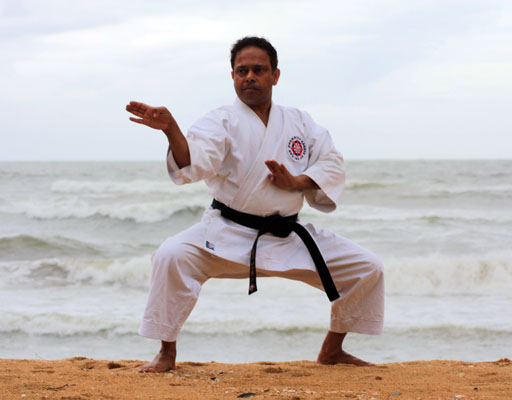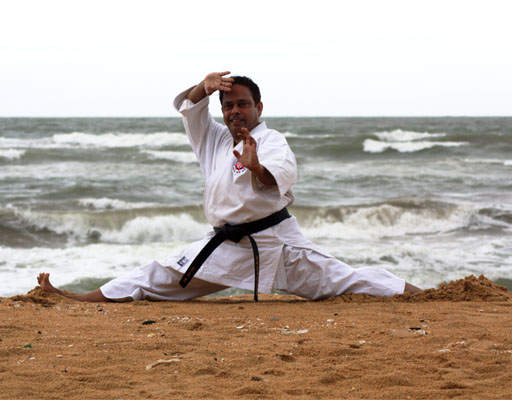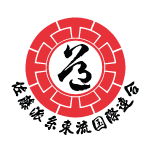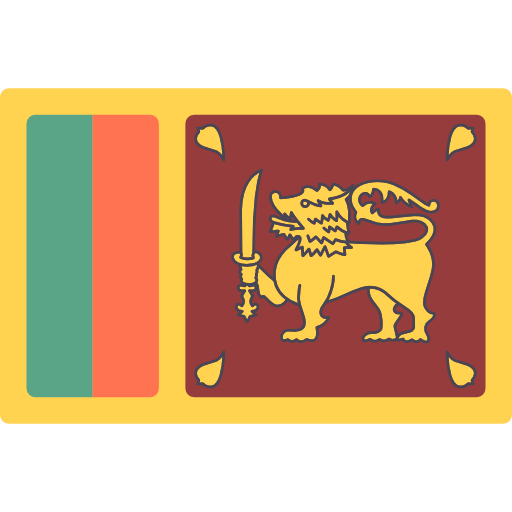JAPAN KARATE-DO DHAMMIKA-HA SHITO-RYU KAI
日本空手道ダミカ派糸東流会
Our history
Dhammika Karate-Do
We are a karate association for traditional Shito-Ryu, which was founded in 1999 by Shihan Athula after his separation from Hayashi-Ha as Dhammika Karate-Do Kai Kan and renamed Japan Karate-Do Dhammika-Ha Shitoryu Kai (JKDS) in 2021.
To date, numerous dojos from a total of ten countries have joined Japan Karate-Do Dhammika-Ha Shitoryu Kai. JKDS itself is a member of Sato Kai.


Dhammika Karate-Do
Our approach at Dhammika-Ha
In Dhammika-Ha, it does not matter which grandmaster created the traditional katas of the respective Shitō-Ryū schools, but that they are preserved in their traditional Japanese form.
This goes hand in hand with the promotion and preservation of the traditional Shito-Ryu art as well as the dissemination of this art through international co-operation – free of any prejudices.
What is JKDS?
Japan Karate-Do Dhammika-Ha Shito-Ryu Kai (JKDS) is a karate association for traditional Shitō-Ryu Karate, which was founded in 1999 by Shihan Athula Minithanthri. Since its foundation, the JKDS and Shihan Athula have been inextricably linked. Shihan Athula is the president of the JKDS association.
What are the main goals of Dhammika-Ha?

To understand the motivations that led to the founding of Dhammika-Ha, one must take a look into the past and consider the development of karate. Long before karate was even recognized as a martial art in Japan, karate and its predecessors were always practiced in secret by the grandmasters until the end of the 19th century and only passed on from master to student. It was not uncommon for masters to only pass on their knowledge within their own families.
When there was a change in society from 1868 onwards, things in Japan and on Okinawa changed, and karate was no longer practiced in secret. It made its way out of the shadows into the light again. The change in society was caused by the restructuring of the Japanese state which went hand in hand with the renewal of the power of the Tenno and the abolition of the shogunate. With the wave emigration from Okinawa to Hawaii at the beginning of the 20th century, the spread of karate began: first in Hawaii, later in the USA and then in Europe.
As far as we know from tradition, several karate grandmasters such as Soke Kenwa Mabuni, Soke Choki Motobu, Soke Hironori Otsuka, and Soke Chojun Miyagi came together in these times of changes in society, and shared their knowledge and expertise with each other as they also gained further knowledge as well. These meetings were like a council of experts and often took place in Soke Yasuhiro Konishi’s house: sometimes on a single day, sometimes for several weeks and even months. According to the records, Kenwa Mabuni even spent about ten months in Konishi’s house and learned several katas from him in 1927 and 1928.
Although karate is rich in tradition, it wasn’t spared from changes due to the many social changes, and the modernization and systemization of it. Over the course of time, some karate organizations have reoriented and split off itself. Even within the same karate styles, subsequent masters of karate made adjustments and changes to the old tradition Japanese katas and its technics; sometimes for political, sometimes for personal reasons.

Because of the fact that the traditional katas have been changed, Shihan Athula not only perceives a lack of respect for the grandmasters, but also realizes the danger that important knowledge including its original meaning will be lost. Encouraged by his previous karate teachers including grandmasters of the first and second generations who all confirmed him a great grasp, he decided to found his own karate association: Japan Karate-Do Dhammika-Ha Shito-Ryu Kai.
With the founding of his own association, Shihan Athula has made it his business to preserve this knowledge. For Dhammika-Ha, it doesn’t matter from which karate master or from which Shito-Ryu style the traditional Japanese katas come from, nor which Shito-Ryu style is presented. It’s only important that they are preserved in their traditional form.
Overview of other main objectives
- Spreading the art of Karate-Do through international cooperation free of any prejudices.
- Promoting and preserving the art of traditional karate in Shito-Ryu.
- Preservation of the katas in their original form to:
- pay respect and tribute to the deceased grand masters, and
- prevent their meaning from being lost
⇒ because of a lack of attention and / or a lack of understanding, we already lost the meaning of some old katas and its parts.
- Training with like-minded people in a comradely and (family-) friendly atmosphere.
Teaching values like discipline, respect, courtesy, honesty, gratitude, and more.
Affiliated and recognized by




Dhammika Karate-Do is represented in the following countries
Japan Karate-Do Dhammika-Ha Shito-Ryu Kai has branches in numerous countries.
We are represented in the following countries.












